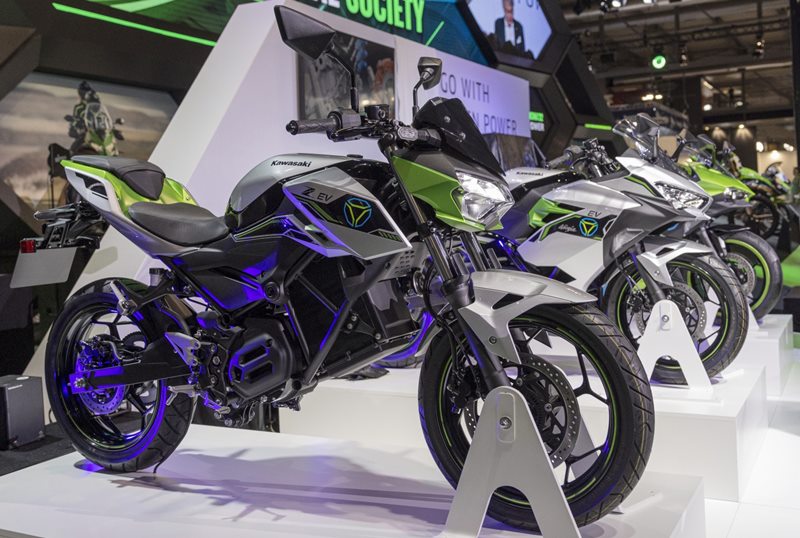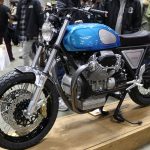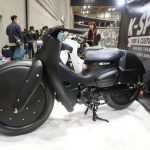The Milan Show (EICMA), one of the world's largest motorcycle trade fairs, was held in Italy from November 8 to 13.
This year's crop of models, especially those under 125 cc, is especially bountiful. Kawasaki became the first major motorcycle manufacturer to release an electric sportbike, and Honda unveiled its first electric model for the general public. In this issue, we will focus on electric motorcycles.
Written: Best Car Editorial Department
This article was originally published in "Best Car Web" on November 27, 2022.
Birth of a cool EV sports motorcycle that can be ridden only with a small automatic transmission.
While other companies were launching internal combustion engine motorcycles, Kawasaki made a big push to focus on electric bikes (EVs) and hybrids.
The Ninja and Z EVs attracted the most attention. Both are pillar brands of the company, the former in full-cowl sport and the latter in naked style. The Ninja is the first major motorcycle manufacturer to offer a motorcycle EV that is not a scooter.
In addition to the Z, which had a demo run at the Suzuka 8 Hours in August, the Ninja was also presented for the first time at EICMA. Although both are prototypes, they are highly complete and appear to be almost production versions.

EV (left) and Ninja EV. The two vehicles share the same basic design, with a newly designed trellis frame. The exterior and suspension are the same as the current Ninja 250 and Z250. Power classification is equivalent to Class 2 mopeds (51 to 125 cc).

The Z and Ninja EV are automatic transmissions without a clutch lever and shift pedal. With fewer components, the motorcycle appears to be lighter in weight. The meter is a TFT LCD
Although it looks like an ordinary motorcycle on the outside, it usually has a battery in the engine section and an electric motor in front of the swingarm. Specifications and other details have not yet been announced, but it will be compatible with the European A1 license (~125cc, 15ps or less).
Two batteries are removable and mounted. The stand-alone weight is quite heavy at about 12 kg, but it would be possible to carry the batteries indoors for charging after parking the motorcycle. The standard of the battery seems to be different from that of the Honda Mobile Power Pack e: which is used for Gachaco, a common standard battery-sharing service (see below).
While the research electric Ninja first unveiled at the 2019 Milan show had a four-speed transmission, the EV presented here lacks a clutch lever and shift pedal and appears to be an automatic transmission. While it will be launched in Europe by the end of 2023, its introduction in Japan is unknown. When it goes on sale in Japan, it will be able to be ridden with a small motorcycle license with limited automatic transmission.
With the Z125 Pro already discontinued, Kawasaki's Japan lineup has zero motorcycles in the 125cc and below class. The Ninja 125 and Z125 with 125cc single-cylinder engines have been released in Europe, but have not been introduced in Japan.
Kawasaki must be the first to introduce an electric sportbike in the 125 class and usher in a new era.

The Z EV and Ninja EV have an air-cooled motor positioned in front of the swingarm. A counter gear is engaged and the ride sprocket is installed on the same axis. The ride system is a chain.

Perspective view of the largest Z EV. It is equipped with two removable batteries with a capacity of 3 kWh. The stand-alone weight is about 12 kg, so it should be possible to transport the vehicle. The part that corresponds to the tank looks like a loading space, from which the batteries are removed.
Is Kawasaki's world's first strong hybrid equivalent to 400cc?
Kawasaki's HEV (hybrid) model, which was demonstrated at the Suzuka 8-Hours endurance race, was also unveiled for the first time in Europe, although it is 125cc or larger. The strong hybrid model, which can run on an engine alone or motor alone, is the first of its kind in the world for motorcycles. It is scheduled to go on sale in Europe in 2024.
While the Ninja and Z EVs are city commuters for short-distance travel, the HEV is intended for longer distances. Displacement has not yet been announced, but the information is that the engine will be 250-400 cc. There is an e BOOST button on the steering wheel, which can be used to improve fuel efficiency or accelerate with the assistance of the motor while the engine is running.
In addition, there is a button to switch between automatic and manual transmission, and it appears to be equipped with a transmission. Since there is no clutch lever or pedal in sight, it appears to be a semi-automatic with button-shift transmission.
Not only is it eco-friendly, but it is also fun to ride. You will be able to enjoy the excitement that is typical of Kawasaki, including EVs.

The Ninja HEV was revealed at the Milan show. The Ninja HEV is expected to be used on highways with an engine, in town with repeated starting and stopping, and as a hybrid for touring in the suburbs.

Ninja HEV can be switched between AT/MT with a button and shifted with a +- switch. In addition to HEV/EV, there is also an e-boost switch on the right-hand side. WALK is for pushing and walking.
Honda's first personal EV, EM1 e: has more range than the E-Vino!
Meanwhile, Honda unveiled the world premiere of its personal electric scooter, the EM1 e:. It will go on sale in Europe in the summer of 2023.
Surprisingly, this is the first time Honda to sell EVs in Europe. In Japan, EVs have only been sold or leased exclusively to corporations and government agencies, and no EVs have been introduced for general users.
EM stands for Electric Moped, and its output is equivalent to that of a moped (~50cc). It has a motor on the rear wheel and a removable battery under the seat. It boasts a cruising range (WMTC mode) of over 40 km on a full charge and a maximum speed of 45 km/h. (Incidentally, in Japan, the maximum speed for mopeds is capped at 30 km/h.)
The battery is equipped with Honda Mobile Power Pack e:, a common battery standard in Japan. It is compatible with Gachaco, a new service that installs pre-charged sharing batteries at ENEOS gas stations and public facilities. The first Gachaco battery station was installed in front of the Tokyo Metropolitan Government Building in Nishi-Shinjuku, Tokyo, on October 25, and the service area will be gradually expanded from metropolitan areas such as Tokyo and Osaka.
The rival Yamaha E-beano has a range of approximately 32 km on a full charge (30 km/h constant field test values in standard mode). However, the E-beano can carry a spare battery (sold separately) under the seat. Although the EM1 e: is superior in terms of electric cost performance, the E-Bino can run longer as a result.
Nevertheless, the E-Bino's battery is different from the common standard Mobile Power Pack e:. If Gachaco becomes widely used, the EM1 e: will be dramatically easier to use, as the worry of running out of battery power will be greatly reduced.

The Honda EM1 e: has a sleek, clean appearance. The flat floor with ample legroom is 300 mm wide from front to back. The lights are full LEDs for low power consumption. Local price not yet determined.

Honda EM1 e is available in white, silver, and glossy black in the photo.

The Honda EM1 e: features in-wheels on the rear wheels and a flat floor underfoot. The photo shows silver.
EM1 e: to be introduced in Japan next spring, but may be rented?
The new EM1 e: shares most of its appearance with the U-GO electric scooter, which is being marketed by Chinese local subsidiary Wuyang Honda from 2021. The U-GO, however, has a battery built-in under the floor and requires the connection plug to be detached and operated.
While Japan's introduction of the EM1 e: has not yet been announced, sources say it will appear around April 2023. Honda operates Honda Go Bike Rentals nationwide, and it appears that the vehicle may be introduced as a rental vehicle rather than for general sale.
Pricing in Europe has not yet been announced, and the mobile power pack and dedicated charger are sold separately. The aforementioned U-GO sold in China is extremely inexpensive at 7499-7999 yuan (148,000-158,000 yen) including batteries. If the price is similar to this when it is sold in Japan, the use of U-GO may spread rapidly.
Expect more details to be announced at the East-West Motorcycle Show to be held in Japan in March. In addition, Honda plans to introduce more than 10 EVs worldwide by 2025, and the EM1 e: will be the first of these. Watch for more new EVs in the future.

Gachaco Battery Station.
By exchanging an out-of-charge battery for a charged one, the low range can be compensated for and there is no waiting time for recharging. Of course, there is no need to ask to be recharged.

One Mobile Power Pack:e is stored under the seat. Unfortunately, it cannot hold a helmet, but it can carry small items.

Mobile Power Pack:e weighs 10.3 kg with lithium-ion batteries; two hands would be able to carry it.
Dimensions are H298 x L156.3 x W177.3 mm.

U-GO is on sale in China since 2021. The battery is uniquely designed and boasts a range of more than 65 km.



